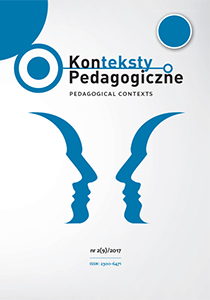Abstract
The present article is to focus on aspects connected with the positive psychology and their possible implementation into the classroom setting. The research sample that consisted of 27 preservice teachers was interviewed in order to elicit factors that, from their perspective, are of crucial importance while teaching as well as some key characteristics of a good language teacher. Qualitative data analysis revealed that most of the categories mentioned by the informants of the study were directly linked to the positive psychology.
References
Blum, R.W., McNeely, C.A. & Rinehart, P.M. (2002). Improving the odds: the untapped power of schools to improve the health of teens. Minneapolis: University of Minnesota, Center for Adolescent Health and Development.
Dörnyei, Z. (2001). Motivational strategies in the language classroom. New York: Cambridge University Press.
Elias, M.J., Zins, J.E., Weissberg, R.P., Frey, K.S., Greenberg, M.T., Haynes, N.M. et al. (1997). Promoting social and emotional learning: guidelines for educators. Alexandria, VA: Association for Supervision and Curriculum Development.
MacIntyre, P.D, Gregersen, T. & Mercer S. (2016). Positive psychology in SLA. Bristol: Multilingual Matters.
Mayer, J.D. & Salovey, P. (1997). What is emotional intelligence?. In: P. Salovey & D.J. Sluyter (eds.), Emotional development and emotional intelligence: Educational implications (p. 3–34). New York: Harper Collins.
Meyer, D.K. & Turner, J.C. (2006). ReConceptualizing emotion and motivation to learn in classroom contexts. Educational Psychology Review, 18, 377–390.
Mayring, Ph. (2001). Combination and integration of qualitative and quantitative analysis. Forum Qualitative Social Research, 2(1), art. 20, http://www.qualitativeresearch.net/fqstexte/101/101mayringd.htm [accessed: 5.2017].
O’Grady, P. (2013). Positive psychology in the elementary school classroom. New York, NY: Norton.
Oxford, R.L. & Cuéllar, L. (2014). Positive psychology in crosscultural learner narratives: Mexican students discover themselves while learning Chinese. In: P. MacIntyre & T. Gregersen (eds.), Positive psychology and language learning. Special issue, Studies in Second Language Learning and Teaching, 4(2), 173–203.
Oxford, R.L. (2014). What we can learn about strategies, language learning, and life from two extreme cases. Studies in Second Language Learning and Teaching, 4(4), 593–615.
Oxford, R.L. (2016a). Powerfully positive: searching for a model of language learner wellbeing. In: D. GabryśBarker & D. Gałajda (eds.), Positive Psychology Perspectives on foreign language learning and teaching (p. 21–37). New York: Springer.
Oxford, R.L. (2016b). Toward a psychology of wellbeing for language learners: the “EMPATHICS” vision. In: T. Gregersen, P. MacIntyre & S. Mercer (eds.), Positive psychology in SLA. (p. 10–90). Bristol: Multilingual Matters.
Seligman, M. (2011). Flourish: A visionary new understanding of happiness and well-being. New York: Atria/Simon & Schuster.Seligman, M. & Csikszentmihalyi, M. (2000). Positive psychology: An introduction. American Psychologist, 55,5–14.
Seligman, M., Reivich, K., Jaycox L. & Gillham, J. (1995). The optimistic child. New York: Houghton Mifflin.
Wang, M., Haertel, G. & Wallberg, H. (1997). What do we know: Widely implemented school improvement programs. Philadelphia: Temple University Laboratory for Student Success.
Weissberg, R.P. (2000). Improving the lives of millions of school children. American Psychologist, 55(11), 1360–1372.
Wilson, H.K., Pianta, R.C. & Stuhlman, S.M. (2007). Typical classroom experiences in first grade: The role of classroom climate and functional risk in the development of social competences. The Elementary School Journal, 108, 82–96.
In accordance with the recommendation of the Ministry of Science and Higher Education, which aims to counteract the practice of “ghostwriting” and “guest authorship,” all authors submitting their text for publication should attach an author’s statement which declares the contribution of each of the authors to the article. The printed and signed statement should be delivered by mail or other means to editor-in-chief Joanna Skibska or sent in the form of a scan to the following e-mail address: redakcja@kontekstypedagogczne.pl. The authors will not receive remuneration for publishing their papers. The editors reserve the right to make minor editorial changes to the articles which will not affect the substance of the article. We encourage all authors to prepare their articles in accordance with the guidelines for manuscript preparation. Download pdf file.
Authors transfer all copyrights and grant the journal the right of first publication with the work simultaneously licensed under a Creative Commons Attribution License that allows others to share the work with acknowledgement of the work's authorship and initial publication in this journal. All authors agree to the publishing of their email addresses, affiliations and short bio statements with their articles during the submission process.

